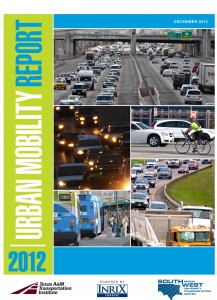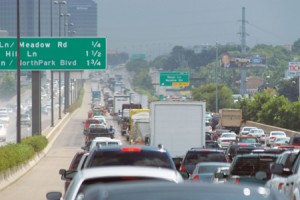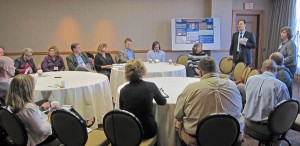At a recent forum on the University of Texas campus, Dr. Talia McCray discusses findings from two of her recent SWUTC research efforts – how to change the perceptions of cycling and transit use in the African American community.
Voice-to-text Apps Offer No Driving Safety Benefit; as with Manual Texting, Reaction Times Double
 Texting drivers may believe they’re being more careful when they use the voice-to-text method, but new research findings suggest that those applications offer no real safety advantage over manual texting.
Texting drivers may believe they’re being more careful when they use the voice-to-text method, but new research findings suggest that those applications offer no real safety advantage over manual texting.
The study is the first of its kind, as it is based on the performance of 43 research participants driving an actual vehicle on a closed course. Other research efforts have evaluated manual versus voice-activated tasks using devices installed in a vehicle, but the TTI analysis is the first to compare voice-to-text and manual texting on a handheld device in an actual driving environment.
Drivers first navigated the course without any use of cell phones. Each driver then traveled the course three more times performing a series of texting exercises – once using each of two voice-to-text applications (Siri for the iPhone and Vlingo for Android), and once texting manually. Researchers then measured the time it took each driver to complete the tasks, and also noted how long it took for the drivers to respond to a light which came on at random intervals during the exercises.
Major findings from the study included:
- Driver response times were significantly delayed no matter which texting method was used. In each case, drivers took about twice as long to react as they did when they weren’t texting. With slower reaction times, drivers are less able to take action in response to sudden roadway hazards, such as a swerving vehicle or a pedestrian in the street.
- The amount of time that drivers spent looking at the roadway ahead was significantly less when they were texting, no matter which texting method was used.
- For most tasks, manual texting required slightly less time than the voice-to-text method, but driver performance was roughly the same with both.
- Drivers felt less safe when they were texting, but felt safer when using a voice-to-text application than when texting manually, even though driving performance suffered equally with both methods.
Christine Yager, a TTI Associate Transportation Researcher who managed the study, says the findings offer new insight, but only a part of the knowledge that’s needed to improve roadway safety. “Understanding the distracted driving issue is an evolving process, and this study is but one step in that process,” she says. “We believe it’s a useful step, and we’re eager to see what other studies may find.”
The study’s results are being published during National Distracted Driving Awareness Month. Numerous agencies, including the Texas Department of Transportation (TxDOT) are sponsoring public awareness campaigns to highlight the dangers of driving distractions, particularly those associated with cell phone use.
Another TTI study now underway is examining the motivations and attitudes of distracted drivers. Results from the focus groups and a 3,000-driver survey are expected in late summer, and will include a look at which demographic groups are most affected by the distracted driving issue.
The Texas A&M Transportation Institute is a member of the Texas A&M University System.
Complete SWUTC Voice-to-Text Study Report
For more information about this study, contact: Christine Yager, Associate Transportation Researcher, Texas A&M Transportation Institute, (979) 845-6528
2012 Urban Mobility Report Released
 Includes New Measures of Congestion
Includes New Measures of Congestion
As traffic congestion continues to worsen, the time required for a given trip is becoming more unpredictable, and researchers now have a way to measure that degree of unreliability, introduced for the first time as part of the annual Urban Mobility Report (UMR). The 2012 UMR is published by the Texas A&M Transportation Institute (TTI), with sponsorship from the Southwest Region University Transportation Center, and in partnership with INRIX, a leading private-sector provider of travel time information for both commuters and shippers. The combination produces a thorough and detailed illustration of traffic problems in 498 U.S. urban areas.
The eroding reliability of travel conditions nationwide is illustrated by the Planning Time Index (PTI), which measures the amount of extra time needed to arrive on time for higher priority events, such as an airline departure, just-in-time shipments, medical appointments or especially important social commitments. If the PTI for a particular trip is 3.00, a traveler would allow 60 minutes for a trip that typically takes 20 minutes when few cars are on the road. Allowing for a PTI of 3.00 would ensure on-time arrival 19 out of 20 times.
PTIs on freeways vary widely across the nation, from 1.31 (about nine extra minutes for a trip that takes 30 minutes in light traffic) in Pensacola, Florida, to 5.72 (almost three hours for that same half-hour trip) in Washington, D.C., according to the study by TTI, a member of The Texas A&M University System.
Rankings of the nation’s most congested cities vary slightly from year to year, and many of this year’s top 10 are repeat performers. Washington, D.C. tops the list, followed by Los Angeles, San Francisco-Oakland, New York-Newark and Boston. The second five include Houston, Atlanta, Chicago, Philadelphia and Seattle. The report provides a detailed illustration of traffic problems in a total of 498 U.S. urban areas.
In addition to PTI, the 2012 UMR also debuts an estimate of the additional carbon dioxide (CO2)emissions attributed to traffic congestion: 56 billion pounds – about 380 pounds per auto commuter. The analysis of CO2 was made possible by funding from the National Center for Freight and Infrastructure Research and Education (CFIRE).
Traffic congestion in U.S. cities has remained relatively stable in recent years and continues to underscore the link between traffic and the economy, according to the UMR. As the nation’s job picture has slowly improved, some congestion measures in 2011 were generally comparable to the year before.
Fuel wasted in congested traffic reached a total of 2.9 billion gallons – enough to fill the New Orleans Superdome four times. That’s the same as 2010, but short of the 3.2 billion gallons wasted in 2005. The Travel Time Index (the difference in time required for a rush hour commute compared to the same trip in non-congested conditions) remained steady at 1.18, still short of the 1.23 level in 2005.
 The total financial cost of congestion in 2011 was $121 billion, up one billion dollars from the year before and translating to $818 per U.S. commuter. Of that total, about $27 billion worth was wasted time and diesel fuel from trucks moving goods on the system.
The total financial cost of congestion in 2011 was $121 billion, up one billion dollars from the year before and translating to $818 per U.S. commuter. Of that total, about $27 billion worth was wasted time and diesel fuel from trucks moving goods on the system.
“The methods and measures developed by TTI and used in the Urban Mobility Report have been successfully implemented for policy making and prioritizing congestion-mitigating projects,” says report co-author and researcher Tim Lomax. “In light of the recent signing of the Moving Ahead for Progress in the 21st Century (MAP-21) Act, there is greater importance on using such measures to prioritize transportation improvement spending to get the highest investment return for the public.
Researchers recommend a balanced and diversified approach to reducing traffic congestion – one that focuses on more of everything. Their strategies include:
- Get as much use as possible out of the transportation system we have.
- Add roadway and public transportation capacity in the places where it is needed most.
- Change our patterns, employing ideas like ridesharing and flexible work times to avoid traditional “rush hours.”
- Provide more choices, such as alternate routes, telecommuting and toll lanes for faster and more reliable trips.
- Diversify land development patterns, to make walking, biking and mass transit more practical.
- Adopt realistic expectations, recognizing for instance that large urban areas are going to be congested, but they don’t have to stay that way all day long.
The complete report, including individual data for all major urban areas, is available at http://mobility.tamu.edu/
A Green Energy Application to Traffic Control
A recent SWUTC study examines the deployment of solar-powered traffic control devices by evaluating the installation and maintenance costs of solar panels and LED retrofits versus traditional incandescent bulb installations. Using data gathered in Houston, Texas researchers found that retrofitting traditional incandescent bulbs to LED, while initially costly, will yield benefits in less than five years. And with the installation of solar panels, energy consumption would be pushed to virtually zero. With the solar panel’s 35-40 year life span, the long-term benefits of their installation outweigh the initial costs.
Latest study results were highlighted in the January 2013 issue of Roads & Bridges in an article titled: Traffic Sunlights: Houston Takes a Hard Look at Solar-Powered Devices.
For more information on this study, contact: Khosro Godazi, Texas Southern University, (713) 313-7925
SWUTC Hosts Productive Symposium
Travel Surveys: Moving from Tradition to Practical Innovation
The SWUTC Travel Survey Symposium was held in Dallas on November 8 and 9. This event was attended by more than 70 travel survey professionals from across the United States, from Florida to Alaska, with one attendee from the City of Calgary (Canada) as well, representing an almost equal mix of agency, consultant, and academic researchers. The symposium started with a poster session, featuring research from 22 related efforts. This was followed by an opening session that included a Texas welcome from Mr. Michael Morris, Executive Director of North Central Texas Council of Governments (NCTCOG) and a key note speech from Dr. Kermit Wies of the Chicago Metropolitan Agency for Planning. Attendees were encouraged to think outside the box and consider all users of travel survey data as their customers.
The symposium was divided into two parts. The discussion groups on Thursday focused on identifying lessons learned and opportunities to advance methods and sampling approaches, as well as considering all uses of the survey data. The day ended with attendees presenting their versions of the “travel survey of the future” – incorporating new technologies, known and on the horizon. Friday, the focus of the symposium discussion turned to identifying what can be implemented now and establishing a research agenda to move us toward the newly identified survey designs. Overall, the symposium received very positive reviews from the attendees.
The Travel Survey Symposium was extraordinary in several ways. First, it attracted a very high proportion of the true thought leaders in the field. Second, it was very timely in that our traditional methods of travel survey have over-relied on the telephone which is failing us. But at the same time technology such as smart phones and GPS are in wide-spread use and have great potential for travel data collection. Finally, the program committee designed an engaging sequence of activities which deviated from the typical conference presentations and encouraged peer exchange and active participation by all attendees. – Attendee Lisa Aultman-Hall
A compendium with details of the discussions and recommendations is in-process and anticipated to be released in mid-January 2013.

